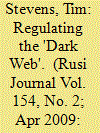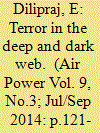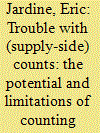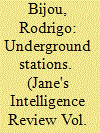| Srl | Item |
| 1 |
ID:
144870


|
|
|
|
|
| Summary/Abstract |
The terms Deep Web, Deep Net, Invisible Web, or Dark Web refer to the content on the World Wide Web that is not indexed by standard search engines. One can describe the Internet as composed of layers: the “upper” layer, or the Surface Web, can easily be accessed by regular searches. However, “deeper” layers, the content of the Deep Web, have not been indexed by traditional search engines such as Google. Michael K. Bergman who wrote the seminal paper on the Deep Web, compared searching the Internet to dragging a net across the surface of the ocean: a great deal may be caught in the net, but there is a wealth of information that is deeper and therefore missed. In fact, most of the Web's information is buried far down on sites, and standard search engines are unable to access it.
|
|
|
|
|
|
|
|
|
|
|
|
|
|
|
|
| 2 |
ID:
087913


|
|
|
|
|
| Publication |
2009.
|
| Summary/Abstract |
The internet plays a contributory role in radicalisation, but is only one of a number of mechanisms currently deployed to win recruits to global jihad. Technical regulation of online content is difficult and may be counter-productive, driving forums deeper underground or alienating users. Tim Stevens argues that adopting a social approach that educates and empowers online communities could have more success.
|
|
|
|
|
|
|
|
|
|
|
|
|
|
|
|
| 3 |
ID:
137829


|
|
|
|
|
| Summary/Abstract |
Starting as a mere concept named “Galactic Network” by J.C.R. Licklider of MIT in August 1962, the ‘internet’ has in the past few decades revolutionised the way this world communicates. Having been technically nurtured in the Defence Advanced Research Projects Agency (DARPA) from early the 1960s to the late 1970s, the internet, i.e. the then ARPANET, has undergone various phases, starting with the sending of host-to-host messages with mere packet switching technology in extreme low speed (2.4 kbps – 50kbps) in 1969, to the advancement of the host-to-host protocol of ARPANET called “Network Control Protocol” (NCP) in 1970, to the introduction of ‘electronic mail’ service in 1972 for an easy coordination mechanism in ARPANET.
|
|
|
|
|
|
|
|
|
|
|
|
|
|
|
|
| 4 |
ID:
163801


|
|
|
|
|
| Summary/Abstract |
Many national security threats now originate on the Dark Web. As a result of the anonymity of these networks, researchers and policymakers often use supply-side data (i.e. the number of sites) as a threat metric. However, the utility of these data depends upon the underlying distribution of users. Users could be distributed uniformly, normally or in a power law across Dark Web content. The utility of supply-side counts varies predictably based upon the underlying distribution of users. Yet, the likelihood of each distribution type varies inversely with its utility: uniform distributions are most useful for intelligence purposes but least likely and power law distributions are least useful but occur most commonly. Complementing supply-side counts with demand-side measures can improve Dark Web threat analysis, thereby helping to combat terrorism, criminality and cyberattacks.
|
|
|
|
|
|
|
|
|
|
|
|
|
|
|
|
| 5 |
ID:
149875


|
|
|
|
|
| Summary/Abstract |
The high public profile of the theoretically anonymous Tor network has made it a key target for law enforcement. As Tor-related arrests and takedowns multiply, Rodrigo Bijou examines how other privacy platforms and networks may come to take its place.
|
|
|
|
|
|
|
|
|
|
|
|
|
|
|
|